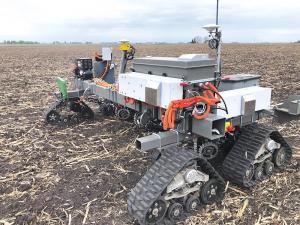2022 - Volume #46, Issue #5, Page #03
[ Sample Stories From This Issue | List of All Stories In This Issue | Print this story
| Read this issue]
First-Of-Its-Kind Electric Planter
 |
As co-founder and CEO of Salin 247, he’s working to make this machine a reality for corn and soybean farmers.
“We’ve been testing our second prototype which recently finished planting on seven different farms in Iowa, Tennessee and Kansas,” says Krog.
The autonomous battery-powered planter is a drive unit designed for carrying another company’s proven planting, spraying and side dressing equipment.
This year, it used White brand planter row units. Individual units were attached to their own 5 by 7-in. toolbars and in turn, mounted to the planter’s 7 by 7-in. bars. Drive tracks feature their own 4 by 4-in. bars fastened to the planter.
A 5-kW electric motor powers each of four gearbox-driven track systems. Motor power is supplied by a 350-lb. 10-kW hour lithium iron phosphate battery which holds about a 90-min. charge while continuously planting.
Krog explains in their first prototype they swapped a second battery into position when the first lost power but without an automatic replacement system they decided to mount a gas-powered generator on the toolbar instead. The generator continuously charges the single battery, removing the need for stopping to replace it.
“We didn’t necessarily want to do this but for now it makes sense,” Krog says. “Ultimately our idea is to go with diesel if we must use a generator so we can use 100 percent biodiesel.”
The unit is light, so airbags are used to apply downforce. In future versions, they’re looking to switch this feature to hydraulic cylinders to provide individual row force.
Navigation is accomplished by real-time kinematics (RTK), GPS, precision planting software, sensors and a prototype Gen 3 20|20 monitor.
“At this stage we’re taking a simple approach, saying ‘start on this side of the field and here’s the route you’re going to plant.’ Ultimately, we want to use machine learning. We might still lay out the AB navigation lines but have the machine smart enough to figure out where to start, how to plant and where to turn.”
The electric planter is 10 ft. wide with 4-row, 30-in. rows but they’re working on adapting it to 15-in. spacing for corn. A 20-ft. unit is also in the works.
Krog explains they would like to add an autonomous docking station for refilling seed, chemicals and fertilizer.
For the coming year, they plan to provide a custom farm model to allow farmers a view of how the unit works and evaluate the possibilities for their own operations.
“Of course, many farmers have large planters and don’t want to trade down for smaller equipment, so we pitch our units to add capacity to existing equipment. One or two of our electric planters can take care of the smaller, irregular-shaped fields while they use their larger equipment on the bigger areas. It’s a way to help everything become more productive.”
Contact: FARM SHOW Followup, Dave Krog, Salin 247, 2316 230th St., Suite 501, Ames, Iowa 50014-6333 (ph 515-418-2952; dave@salin247inc.com; www.salin247inc.com).

Click here to download page story appeared in.

Click here to read entire issue
To read the rest of this story, download this issue below or click here to register with your account number.




